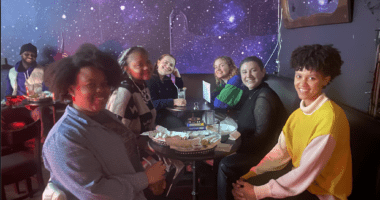Patti Chilsen, CWP’s Assistant Program Director: Training + Evaluation, facilitates pre- and post-arts residency surveys of CWP classroom students. At one of our partner schools she encountered a resistant student which brought up important issues regarding evaluation.
I was facilitating CWP post-evaluations in a third grade class when a young boy quietly sidled up beside me. Shyly, and somewhat glumly, he handed me his survey. I said thank you. Something about this boy’s survey caught my eye. I noticed that he had written “nothing” in all the qualitative response slots. He had also circled all zeros in the quantitative responses, and written only one sentence for the essay response.
I knelt down by his desk and asked if he wanted to review his responses. He shook his head no. I asked if he was upset. He nodded his head yes. I asked if he was upset over Community-Word Project and he shook his head no. I asked if it was something outside of school. He nodded his head.
I told him that art can give us a way to show our emotions, even ones we feel when we are upset. When I had arrived earlier, I noticed he had been coloring a sketch of the class mural they were creating, so I mentioned how coloring is one way to express emotions. Brimming with tears moments before, now his dark eyes sparkled. “Can I color the picture on the survey?” he asked eagerly. I automatically replied, “Yes!”
I felt sure I would get a picture colored black or deep red or purple from that young boy. When I picked up his paper, he smiled at me. He had colored the picture one vibrant shade of sunlight yellow.
Educators are consumed with measuring student success and student growth. We are compelled to somehow grasp on paper the significance of our impact in the classroom. At the same time trapped by traditional routes of measurement for what often evades typical assessment.
Administrations and funders clamor for data that proves we are reaching and teaching our students. I get it. We have to know we are doing what we say we do. Assessing our impact can also show how to improve our effectiveness. We must be accountable and able to reveal that our work provides focused instruction with lessons targeted on the growth and development of the children.
Many educators are working to develop systems that show how deeply the arts build not only the ability to express but to think creatively, and that art-making involves myriad critical thinking skills. Quality arts integration reaches essential aspects of the learner, providing opportunities to:
- express, and convey complex, intangible ideas
- analyze and “read” not only what is expressed but how it is conveyed
- compare and contrast
- make choices and work to implement them
- alter the course when things go wrong, or not quite as you had planned
- rethink, revise, and edit
- explore and push beyond the edges of what is known at the moment
- assess and self-evaluate in the process, which impacts end-product
- reflect and grow, respond, communicate and create
This is how arts in education intertwines with college and career readiness.
Traveling from the classroom back to my office, I thought about how those zeros and nothings were going to affect my averages. I thought about how this system did not reflect that young boy’s experience with Community-Word Project in his classroom. I thought about his sad face and brooding eyes. And how they brightened at the prospect of coloring the image on the survey. How was I to record what that beaming yellow color he used meant to this student? How was I to record what he felt about his experience? His love for arts in his classroom? His ability in a dark moment to express a joyful feeling?
“The only man who behaves sensibly is my tailor; he takes my measurements anew every time he sees me, while all the rest go on with their old measurements and expect me to fit them.” – George Bernard Shaw



